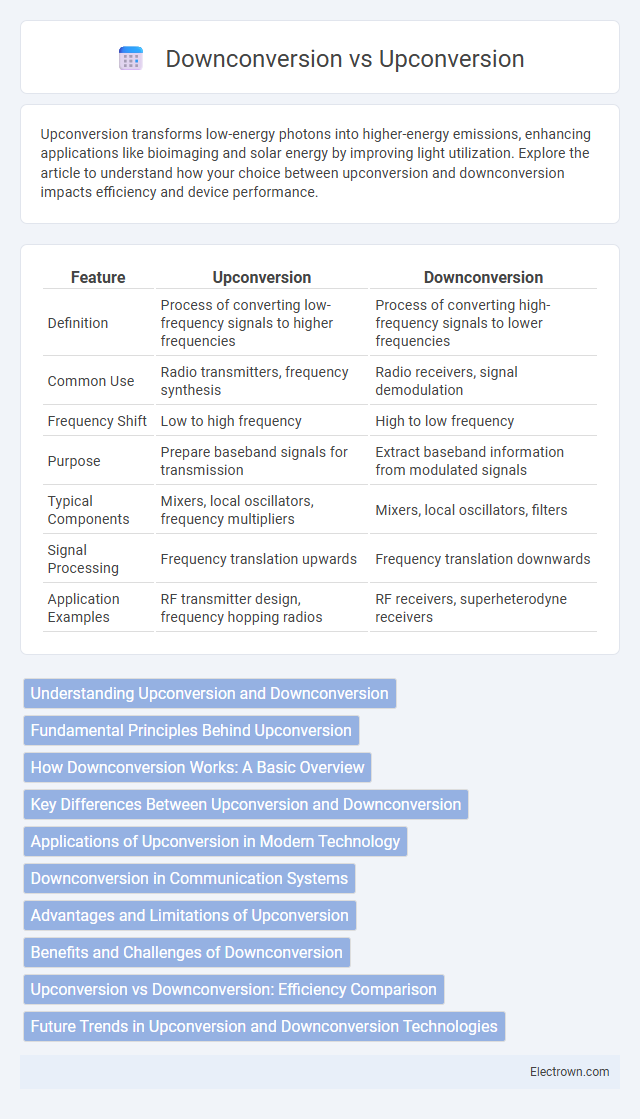Upconversion transforms low-energy photons into higher-energy emissions, enhancing applications like bioimaging and solar energy by improving light utilization. Explore the article to understand how your choice between upconversion and downconversion impacts efficiency and device performance.
Table of Comparison
| Feature | Upconversion | Downconversion |
|---|---|---|
| Definition | Process of converting low-frequency signals to higher frequencies | Process of converting high-frequency signals to lower frequencies |
| Common Use | Radio transmitters, frequency synthesis | Radio receivers, signal demodulation |
| Frequency Shift | Low to high frequency | High to low frequency |
| Purpose | Prepare baseband signals for transmission | Extract baseband information from modulated signals |
| Typical Components | Mixers, local oscillators, frequency multipliers | Mixers, local oscillators, filters |
| Signal Processing | Frequency translation upwards | Frequency translation downwards |
| Application Examples | RF transmitter design, frequency hopping radios | RF receivers, superheterodyne receivers |
Understanding Upconversion and Downconversion
Upconversion involves the process of converting lower-energy photons into higher-energy photons, enhancing applications such as bioimaging and solar energy harvesting. Downconversion, conversely, transforms high-energy photons into multiple lower-energy photons, improving the efficiency of devices like LEDs and photovoltaic cells. Understanding the distinct mechanisms and applications of upconversion and downconversion can optimize Your use of materials for photonic and energy technologies.
Fundamental Principles Behind Upconversion
Upconversion relies on the sequential absorption of two or more low-energy photons, typically infrared, to emit a single higher-energy photon, often in the visible or ultraviolet range. This process involves intermediate energy states or energy transfer between ions, commonly lanthanide ions such as Er3+, Tm3+, or Ho3+, embedded in host materials like NaYF4. The efficiency of upconversion is influenced by factors such as crystal field environment, ion concentration, and excitation power density, enabling applications in bioimaging, photovoltaics, and security inks.
How Downconversion Works: A Basic Overview
Downconversion involves transforming higher-frequency signals into lower-frequency ones by mixing the input signal with a local oscillator in a nonlinear device, producing an intermediate frequency (IF) output. This process simplifies signal processing in communication systems by enabling easier filtering, amplification, and demodulation at the IF stage. Downconversion is essential in radio receivers, radar systems, and satellite communications to efficiently handle high-frequency signals.
Key Differences Between Upconversion and Downconversion
Upconversion involves the absorption of two or more low-energy photons followed by the emission of a higher-energy photon, whereas downconversion refers to the absorption of a high-energy photon and the emission of two or more lower-energy photons. Key differences include the direction of energy transfer, with upconversion converting infrared or visible light to shorter wavelengths like visible or ultraviolet light, while downconversion shifts ultraviolet or visible light to longer wavelengths such as near-infrared. These processes impact applications differently, with upconversion being valuable in bioimaging and photovoltaics, and downconversion enhancing lighting efficiency and solar cell performance.
Applications of Upconversion in Modern Technology
Upconversion technology enables the conversion of low-energy photons into high-energy photons, making it invaluable in fields like bioimaging, where enhanced fluorescence improves cellular visualization. In photovoltaics, upconversion materials boost solar cell efficiency by transforming infrared light into visible light that can be absorbed by photovoltaic layers. This process also advances security features in anti-counterfeiting measures through unique luminescent patterns activated under specific light conditions.
Downconversion in Communication Systems
Downconversion in communication systems involves converting a high-frequency received signal to a lower intermediate frequency (IF) for easier processing and demodulation. This process uses mixers and local oscillators to shift the spectrum without losing information, enabling efficient filtering and amplification. Your receiver relies on downconversion to improve signal quality and simplify the extraction of the baseband data.
Advantages and Limitations of Upconversion
Upconversion offers the advantage of converting low-energy photons into higher-energy emissions, enabling improved sensitivity in bioimaging and enhanced solar cell efficiency by utilizing sub-bandgap infrared light. Its limitations include relatively low quantum efficiency and the need for complex, often costly, lanthanide-doped materials, which can hinder large-scale commercial applications. Despite these challenges, upconversion remains a promising technology for applications requiring deep tissue penetration and reduced background fluorescence.
Benefits and Challenges of Downconversion
Downconversion offers the benefit of converting high-energy photons into lower-energy photons, enabling efficient use of solar cells by matching the energy of incoming light to the cell's bandgap, which enhances photovoltaic efficiency. Challenges include energy losses due to thermalization and difficulties in achieving high quantum yields and material stability for long-term applications. Your choice of downconversion materials directly impacts device performance, requiring careful optimization to balance conversion efficiency and durability.
Upconversion vs Downconversion: Efficiency Comparison
Upconversion efficiency typically remains lower than downconversion due to the need for multiple low-energy photons to combine into a single higher-energy photon, which presents inherent energy losses and complex material requirements. Downconversion processes in luminescent materials convert one high-energy photon into two or more lower-energy photons, often achieving higher quantum efficiencies and improving overall device performance. Optimizing Your application requires considering these efficiency differences to select the appropriate conversion method based on desired spectral output and energy utilization.
Future Trends in Upconversion and Downconversion Technologies
Emerging trends in upconversion and downconversion technologies emphasize enhanced quantum efficiency and broadband spectral conversion for applications in photovoltaics and bioimaging. Advances in nanomaterials and rare-earth doped phosphors are driving improvements in energy harvesting and emission tunability, enabling more efficient solar cells and advanced diagnostic tools. Your access to these innovations can lead to improved device performance and expanded functionality across various optoelectronic systems.
upconversion vs downconversion Infographic

 electrown.com
electrown.com